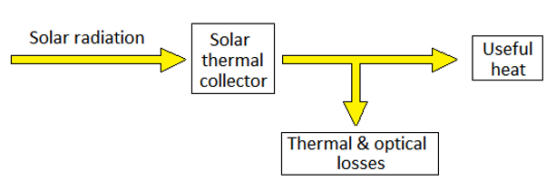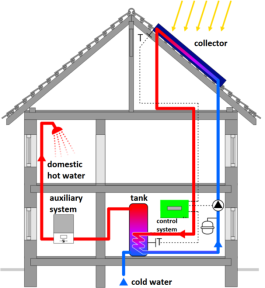Солнечная энергия используется различными способами, такими как: подогрев промышленной и бытовой воды, сушка изделий, обогрев помещений, охлаждение и замораживание, производство энергии и т. д. Все это — употребление солнечной тепловой энергии в том или ином видах. Системы, использующие солнечную энергию, могут быть классифицированы на два типа систем: системы, которые преобразуют солнечную энергию в тепловую энергию и фотоэлектрические солнечные системы, которые преобразуют солнечную энергию в электрическую. О первом типе систем пойдет речь в этой статье.
- Introduction
The planet is progressively marching towards a serious electric energy crisis, due to an increasing need of electric energy becoming greater than its supply. We have always accepted that the energy we make use of each day is not unlimited, still we take it for granted. Coal, petroleum, electrical power, even water has inadequate availability. But, we have not taken sufficient precautions to handle a possible energy crisis. Oil and gas have already become too pricey, and with each passing day, they are becoming being extinct. Prices have been rapidly increasing for the past five years, due to the rising desire and the escalating shortage of energy resources. The solar energy considered as the one source of renewable energy, alternatives to the energy sources.
Solar thermal energy can actively heat a space or it can be also used for indoordomestic water heating. Water that is medium hot is used for daily, indoor needs such as bathing and cleaning and, sometimes, heating of buildings. A variety of solar water heaters can preheat water for use in buildings.
- Overview
The use of solar energy in recent years has reached a remarkable edge. Heating water with the sun is one of the most cost-effective applications of solar energy. Questions of theenergy-efficient installation of different solar water heating systemsbecame a subject of serious scientific researches and the main topic of world congresses such as «Packaged solar water heating technology: twenty years of progress» and «Proceedings of the World Renewable Energy Congress».
Details of thermosyphon solar water heaters installation and its characteristics are considered in the Morrison G. L. and Braun J. E. article «System modeling and operation characteristics of thermosyphon solar water heaters». (Solar Energy 1985).
Ong K. S. considers types of calculation for solar water heating systems by different methods in his scientific researches «A finite difference method to evaluate the thermal performance of a solar water heater» and «An improved computer program for the thermal performance of a solar water heater».
Principals of solar thermal systems design are considered in details by scientist from different countries in researches such as «Optimal design for a thermosyphon solar water heater» (Shariah A. M, Shalabi B.), «Design, construction, performance evaluation, and economic analysis of an integrated collector storage system». (Kalogirou S.), «Principles of solar engineering» (Kreith F, Kreider J. F.).
- Goals and objectives of research
The purpose of the study is to classify the types of domestic hot water solar thermal systems by its operation principle.
Objectives of the study:
to analyze principles of solar thermal systems operation;
to compare different solar thermal systems schemes;
to highlight advantages and disadvantages of each systems type.
- Solar thermal process
Solar thermal process is the conversion of solar radiation into useful heat (e. g. for sanitary hot water and space heating) and other useful «services» through thermally driven processes [2].

Figure 1. Scheme of solar energy distribution
Thermally driven process is the conversion of heat (in the form of a carrier fluid, e. g. water, air, diathermic oil, molten salts) into one or more useful «services» (e. g. cooling, sea water desalination, drying, industrial processes, etc.). [5]
All solar thermal systems for domestic water heating can be divided in two different types:
Thermosyphon water heater (passive systems);
Pumped hot water system (active systems).
- Thermosyphon water heater
Passive systems rely on the natural tendency for hot water to rise (known as thermosiphoning systems). These systems are among the least costly and have no moving parts that may wear out over time. The simplest system, known as a batch or «breadbox» water heater, is something the average do-it-yourselfer can construct at minimal cost. Passive systems consist of a collector, usually a glazed box with a metal tank or piping the inside of which is painted black, and a storage tank, which can be an existing water heater.
The water is heated passively by solar energy and relies on heat energy being transferred from the sun to a solar collector that is usually installed on the roof. [1]
There are different types of solar collectors — unglazed, flat plate, evacuated tubes,etc., each one is suited for a certain temperature range. [4]

Figure 2. Principle of thermosyphon solar water heating systemoperation
The main advantage of a thermosyphon solar water heating system is the fact that hot water risesandcool water sinks. As water is heated it expands and so, as gravity pulls down the relatively heavier cool water pats, the warmer parts rise up. That’s why these kind of solar thermal systems is the most popular in Europe. Such a system offers the advantage that no pump or controller is required to run everything and so it is very simple and less liable to failure.
However, these systems do always need a high capacity component to match demand of energy production to make it possible to use domestic hot water at night.

Figure 3. Typical scheme of thermosyphon solar water heating system installation
- Pumped hot water system
Active systems rely on pumps which circulate water or other liquid through a solar collector. The hot water from the solar collector is usually stored in a typical water heater, which functions as a backup system when the sun is not shining. Although these systems tend to be more expensive, they have higher efficiencies that usually offset the higher initial cost.
Solar circulating pumps ensure that residential and commercial water heating systems always have a ready supply of hot water, there is no waiting for hot water to reach the faucet as it circulates continuously around the pipes. [3]. This saves energy in that’s why you don’t have to leave the tap running as you wait, it also saves water. However, the fact that the pipes are constantly hot results in energy loss, while the pump itself consumes energy.

Figure 4. Typical scheme of pumped hot water system installation
In solar circulating systems, the original source of power to turn the axis of a centrifugal pump comes from the sun.
A pump water heater consists of an insulated storage tank and a heating module. The heating module must be installed outdoors, but there are options to install the storage tank either outdoors with the heating module, or indoors separated from the heating module by up to 4 metres.Heat pumps draw less electricity than a traditional electric storage water heater, and in doing so, are more energy efficient. They do take longer to heat water, so consider a larger tank capacity to ensure you have enough hot water when you need it. [3]
Generally, the material used to manufacture circulating pumps depends on the system; closed loops that don’t receive fresh water regularly are made of cast iron components to protect the pipes from corrosion caused by deoxygenated water. Bronze is typically used to make the pipes in circulating pump systems that receive a fresh supply of oxygenated, potable water.
- Conclusion
Change in global climate and increasing prices of conventional fuel supply have lead to development in solar energy technology, which are non-conventional energy technology. The installation of solar thermal equipment is growing rapidly due to increasing demand of thermal energy. Thermosyphon solar water heating systems are more popular to install because of its low price. However, pumped hot water system can afford using domestic hot water without waiting and there is no need to install a high capacity component.
References:
- W. Hoffman, PV Solar Electricity Industry: Market Growth & Perspective, Solar Energy Materials & Solar Cells 90, 2006.
- J. Duffie, W. Beckman, Solar Engineering of Thermal Processes, 2nd Ed., John Wiley.
- J. Chaves, H-M. Henning, M. Motta, D. Mugnier, Solar Cooling Handbook, 3rd Ed., AMBRA/V.
- Nitin P. Gulhane Ȧ., Kaustubh V., Chavan Ȧ. Thermal Solar Collectors System (International Journal of Current Engineering and Technology ISSN 2277–4106).
- Soteris A., Kalogirou. Solar thermal collectors and applications, Progress in Energy and Combustion Science 30, 2004.
- Renewable Energy World02/2004. pp. 95–99.
- Renewable Energy World 06/2003 pp. 109–113.
- Michael Kanellos, How Solar Thermal Could Move Into Homes June 17, 2009.
- Tim Merrigan. National Renewable Energy Laboratory. Solar Thermal Systems Analysis.
- Dincer I. Energy and environmental impacts: present and future perspectives. Energy Sources, 1998;20(4/5):427–53.
- Duffie J. A., Beckman W. A. Solar engineering of thermal processes. New York: Wiley. 1991.
- Klein S. A. Calculation of flat plate collector loss coefficients. Solar Energy 1975. pp. 79–80.
- Romero M, Buck R, Pacheco J. E. An update on solar central receiver systems projects and technologies. J Solar Energy Engng 2002.
- Meinel A. B., Meinel M. P. Applied solar energy: an introduction. Reading, MA: Addison-Wesley; 1976.
- Sayigh A. A. W. Renewable energy: global progress and examples., WREN 2001; pp. 15–17.
- SERI. Power from the Sun: principles of high temperature solar thermal technology; 1987.
- Dincer I. Renewable energy, environment and sustainable development. Proceedings of the World Renewable Energy Congress V, Florence, Italy; 1998.
- Rosen M. A. The role of energy efficiency in sustainable development. Technology Society 1996; pp. 6–21.
- Colonbo U. Development and the global environment. In: Hollander JM, editor. The energy-environment connection. Washington: Island Press; 1992; pp. 3–14.
- Kreider J. F, Kreith F. Solar energy handbook. New York: McGraw-Hill; 1981.
- TRNSYS Program Manual. Solar Energy Laboratory, University of Wisconsin, Madison, USA; 1996.
- Morrison G, Wood B. Packaged solar water heating technology: twenty years of progress. Proceedings of ISES Solar World Congress on CD-ROM, Jerusalem, Israel; 1999.
- Gupta G. L., Garg H. P. System design in solar water heaters with natural circulation. Solar Energy 1968;12; pp. 163.
- Ong K. S. A finite difference method to evaluate the thermal performance of a solar water heater. Solar Energy 1974;16; pp. 137.
- Ong K. S. An improved computer program for the thermal performance of a solar water heater. Solar Energy 1976;18; pp. 183–191.
- Kudish A. I., Santamaura P., Beaufort P. Direct measurement and analysis of thermosyphon flow. Solar Energy 1985;35: pp. 167–68.
- Morrison G. L., Braun J. E. System modelling and operation characteristics of thermosyphon solar water heaters. Solar Energy 1985;34; pp. 389–405.
- Hobson P. A, Norton B. A design monogram for direct thermosyphon solar energy water heaters. Solar Energy 1989;43:89–95.
- Shariah A. M., Shalabi B. Optimal design for a thermosyphon solar water heater. Renewable Energy 1997;11:351–61.
- Tripanagnostopoulos Y., Souliotis M., Nousia Th. CPC type integrated collector storage systems. Solar Energy 2002; 72(4):327–50.
- Kalogirou S. Design, construction, performance evaluation, and economic analysis of an integrated collector storage system. Renewable Energy 1997; pp. 179–92.
- Kreith F., Kreider J. F. Principles of solar engineering. New York: McGraw-Hill; 1978.
- Anderson B. Solar energy: fundamentals in building design. New York: McGraw-Hill; 1977.
- Morrison G. L. Solar collectors. In: Gordon J, editor. Solarenergy: the state of the art. Germany: ISES; 2001; pp. 145–221.
- TRNSYS Program Manual. Solar Energy Laboratory, University of Wisconsin, Madison, USA; 1996.

